Are you looking for ways to get creative and maximize your hillside landscaping on a budget? Look no further – this guide is here to provide you with all the information and useful tips you need. Whether it’s terracing a slope, creating an eye-catching retaining wall, or adding colorful plants and small water features, there are plenty of ideas for how to make the most of your hillside space without breaking the bank.
How can I landscape my hillside cheaply?
One of the best ways to save money when doing hillside landscaping is by planning ahead and creating a budget for yourself. Knowing how much you can afford to spend on supplies and labor will help you stick to your plan and get the most out of your hillside landscaping project.
You should also think about what kind of plants and flowers are best suited for the terrain, climate, and conditions in your area so that they can thrive without needing expensive upkeep or maintenance. Consider native species that are already adapted to the environment, as well as hardy evergreen plants that can withstand winter weather and other extreme temperatures.
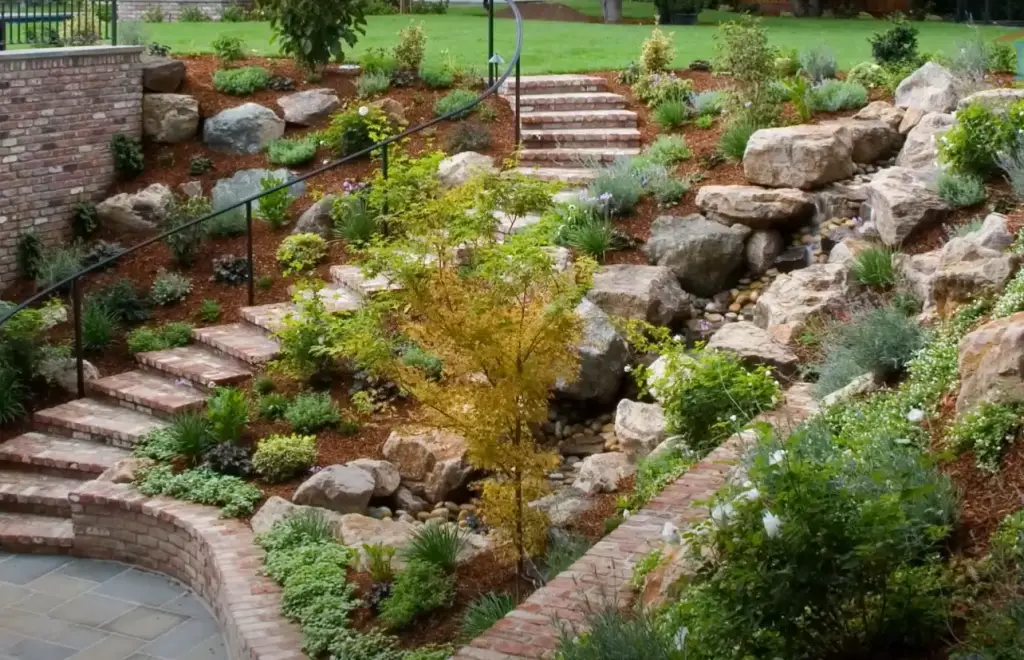
When it comes to materials, keep it simple by using natural stones like gravel, sandstone, or flagstone instead of buying expensive patio tiles. You can also use salvaged materials like bricks or stones from a nearby demolition site to add texture and interest to your hillside landscape without breaking the bank.
Finally, don’t forget the importance of proper planning when it comes to hillside landscaping on a budget. Take your time in selecting plants and materials that fit within your budget while also creating an aesthetically pleasing design. Consider using terraces and retaining walls as well as adding colorful flowers, trees, and shrubs for added visual impact without spending too much money.
What do you put on a hillside?
When landscaping a hillside, there are many options available to you. Depending on your budget and the type of landscape you want to create, you can use trees, shrubs, perennials, grasses, rocks and boulders to bring height, texture and color to the hillside.
Shrubs such as azaleas, rhododendrons and hollies also provide beautiful color and texture along with privacy from neighbors. Perennial herbs like lavender or thyme make great ground covers designed to keep soil in place during heavy rains or melting snow. Grasses such as fescue, rye and bluegrass look great while providing a natural erosion control.To break up the monotony of the hillside, you can use rocks and boulders to create attractive accents. Large flat stones work well for terraces while smaller pebbles are great for pathways or filling in between stepping stones. Boulders, on the other hand, can be used to make retaining walls along the edge of the hill or stacked together to form an interesting focal point. And don’t forget about adding water features like small cascading streams or ponds for added interest and wildlife habitat. With a little creativity, your hillside will soon become an inviting space with beautiful views that you can enjoy all year long!
Craftsmanship and Nature Intertwine on Brick Wall
Brick walls are a great way to add complexity and texture to your hillside landscaping project. Moreover, they can be built relatively easily and quickly, making them perfect for those looking for budget-friendly ideas. Plus, with the variety of styles that you can choose from, such as herringbone or running bond patterns, you’ll be able to create something truly unique and visually appealing.
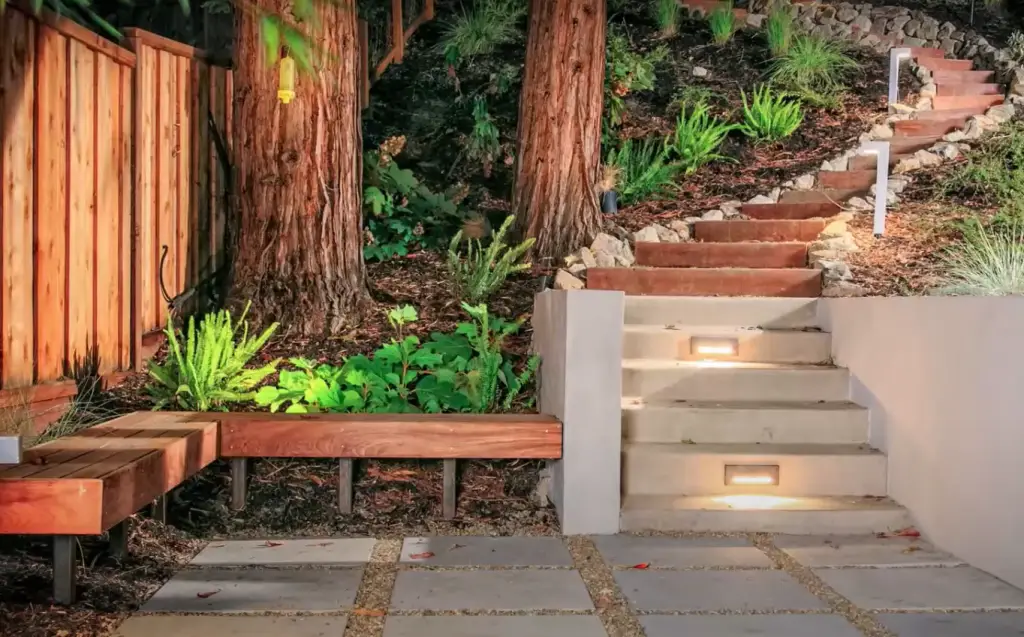
When crafting your brick wall, make sure to use quality materials and skilled labor. This will ensure that it is strong enough to stand up against harsh weather conditions and last long-term. Furthermore, by using craftsmanship techniques like chiseling mortar joints in an uneven fashion or adding distressed bricks here and there, you’ll be able to make your wall look more naturally aged and rustic.
Also, consider adding plenty of plants around your brick wall as this will create a beautiful combination of natural elements with the man-made structure. The colors and textures of different foliage can really help soften the hard edges of the wall, making it look like a harmonious part of nature.
Add Charm to a Rose Garden with Multi-Tiered Seating Area
If you’re looking for a hillside landscaping idea that will add charm and beauty to your garden, consider creating a multi-tiered seating area. By building multiple tiers of seating areas with steps connecting them, you can create an intimate and visually appealing spot for relaxation.
To make this an even more cost-effective project, you can use repurposed materials like old pallets or large bricks as well as other unique items such as logs and stones. With a bit of creativity, this could be one of the most beautiful additions to your hillside garden on a budget!Upgrade Your Hillside with a Stunning Waterfall and Pool
If you’re looking for an exciting way to upgrade your hillside landscaping, why not consider adding a waterfall or pool? This addition can take your hillside from plain and boring to something that looks like it’s straight out of an exotic paradise! Both features can be customized in many ways, from size to shape, materials used, and more. Plus, they provide a wonderful backdrop for outdoor entertaining and enjoying nature.
When considering a waterfall or pool on the hillside, there are several things to keep in mind. First of all, safety is always paramount, so make sure whatever design you choose is secure enough to prevent any accidents. Additionally, depending on the type of feature you want and the size of it, you might need assistance from a professional landscaping company to ensure it’s installed correctly. Finally, you’ll want to factor in the cost of materials and labor when creating your budget.
Opt for Local Plants and Stone Slabs
One of the best ways to keep your project cost-effective is to opt for locally found plants, flowers and trees. You can also use local stone slabs and boulders in place of concrete or other materials to create retaining walls and pathways. Not only will you be saving money by using what’s available nearby, but you will also be helping the environment by choosing eco-friendly materials.
When it comes to planting plants and flowers on a hillside, remember that they must be able to survive in dry conditions. Choose drought-tolerant plants that are native to the area so they can thrive even during periods of little rain or water restrictions. To ensure success, research the local soil type and climate conditions to make sure that any plants you plant will be able to survive.
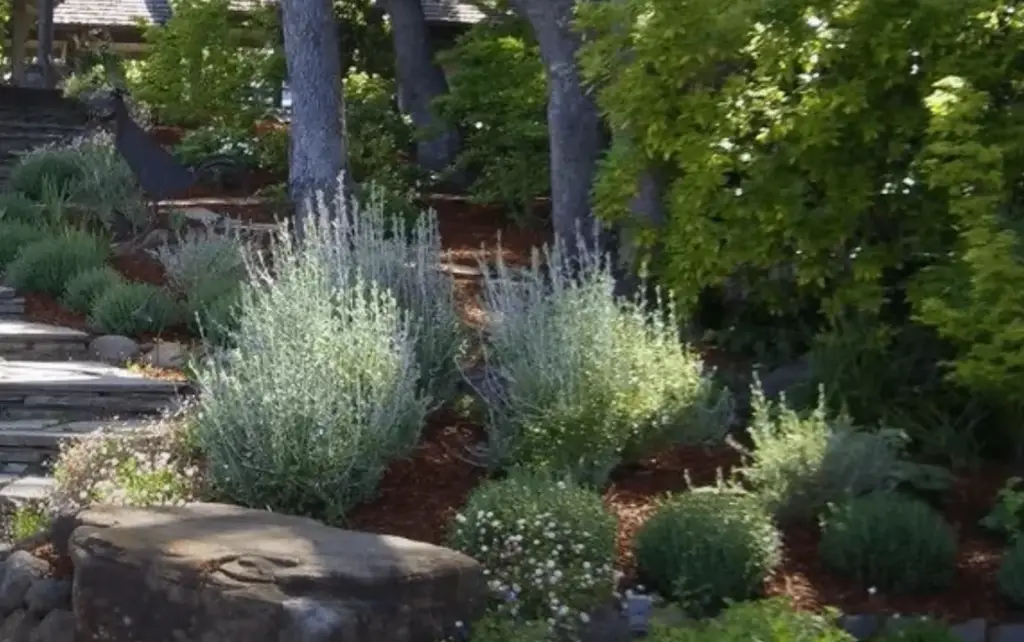
For pathways, look for locally sourced stones or other materials like flagstones that can provide a stable base and won’t break your budget. You can also use mulch or gravel as an inexpensive alternative to concrete and other expensive materials.
Create an Elegant Path with Light-Colored Pavers at Hill Base
One of the most cost-effective ways to spruce up a hillside landscape is by adding an elegant path. This not only adds an attractive feature to the area, but it also allows you to traverse up and down the hill easily and safely. To keep costs down while still achieving a great look, opt for light-colored pavers such as limestone or sandstone. These materials are durable and have a lighter color palette that will stand out against your green hillside backdrop. Installing these pavers in stepping stone-size shapes can add visual interest without breaking the bank. Make sure to seal them so they resist moisture and other elements for years to come!
Show Off Bold Design with Brick Retaining Walls and Stairs
The brick is strong enough to hold back soil, making it perfect for terraced gardens or large flower beds on a sloped surface. You don’t have to break the bank to install brick retaining walls; using salvaged bricks or even faux brick surfaces can save you money while still looking stunning. Make sure you account for proper drainage when planning your stair design; otherwise, water will just collect between the steps and cause problems down the line.
Create a Glamorous Retreat with Stone Slabs Stairs
If you’re looking to create a luxurious and glamorous landscape on a budget, stone slab stairs are the way to go. Stone slabs can provide an elegant look to any outdoor space and will help enhance the beauty of your hillside. Make sure you select stones that are easy to install and durable enough for the area, as well as ones that match the natural color of your landscaping. To keep costs down, consider purchasing pre-cut stones from home improvement stores or online retailers. Additionally, installing them yourself can help save even more money since you won’t be paying for labor costs. Finally, if you want extra flair, add lighting along each step or opt for colorful plants and trees around the perimeter of the stairs to really make your hillside retreat stand out.
Concrete Stairs and Seating with Contrasting Design Elements
By creating low-lying steps on the hillside, you can make it easier for people to navigate the terrain and provide comfortable seating that is both stylish and functional.
For added interest, you can use materials like bricks or stones in contrasting colors to form patterns within the concrete staircase and seating areas. This not only adds visual dimension but also provides more texture and depth to your landscaping project. You could even opt for stamped concrete with a variety of different designs if you want something more unique! Whatever design elements you choose, they will help tie together the entire look of your hillside landscape.
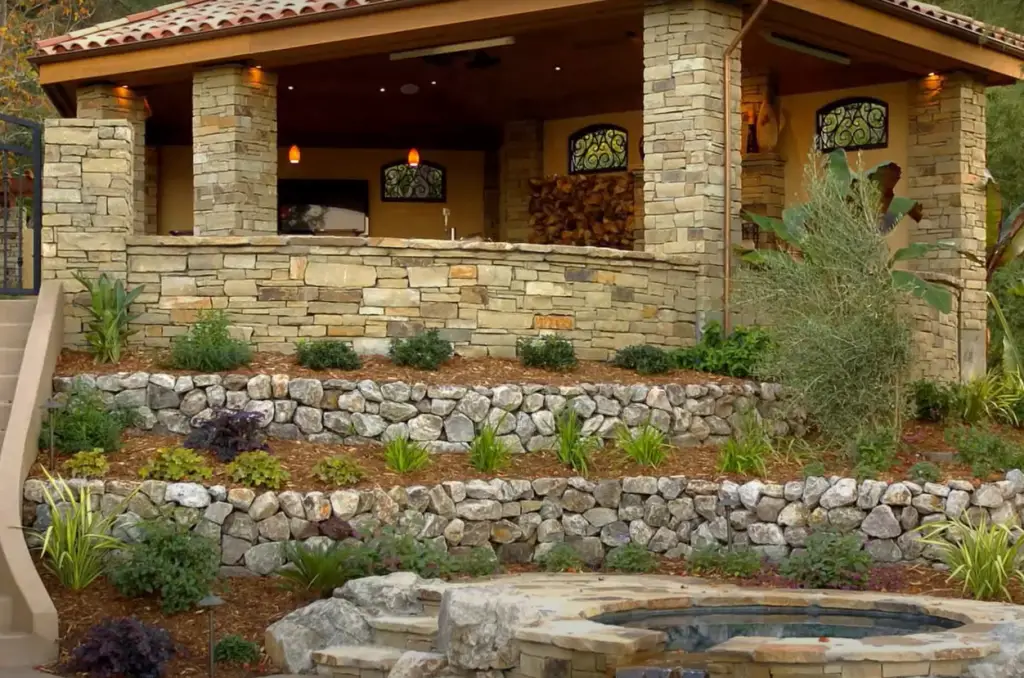
Finally, take advantage of the hillside’s natural beauty by adding some potted plants or shrubs along your stairs and seating areas. This will give it a more organic feel and help to create a stronger connection between the structure and its surrounding environment. With a few simple steps, you can turn an ordinary hillside into a beautiful outdoor living space!
Adorn a Dining Area with Brick and Reclaimed Cement Stairs
To do this, you can use your existing brick walls. This is a great way to create a cozy setting that looks amazing without breaking the bank.
The first step is to lay out the bricks in whatever pattern you like and build up the wall for support. Then, fill in any gaps with mortar. Once done, measure out the length and width of your desired steps on either side of the wall. Then, cut pieces of reclaimed concrete with a masonry saw and stack them to form your stairs. Finally, seal everything together with grout or mortar mix.
This project requires some patience and skill but it can be done with a minimal budget. The end result is an attractive outdoor area that you can use for dining or entertaining friends.
Utilize Large Steps to Divide Your Yard
If your yard has a steep slope, it can be difficult to create separate levels in the hillside landscaping.
Using large steps is a good way to separate different areas of your yard. These large steps will give your landscape an interesting look and provide a safe way to travel up and down the slopes. You can make these steps yourself or purchase them from home improvement stores or online retailers that specialize in outdoor landscaping supplies.When choosing the materials for these steps, ensure they are strong enough to withstand weathering and wear and tear. Natural stone looks great while being durable at the same time. If you prefer something more affordable, you can opt for concrete stepping stones or flagstones. Whatever material you use, make sure the steps are even and secure so that they don’t slip when used.
Creating steps can be a great way to divide your yard into different sections without having to dig up the slope. Additionally, these steps will provide a safe way to navigate the hillside landscape while adding an interesting aesthetic element to your yard.
Modify the Stairway with Creeping Thyme Ground Cover
It will not only help keep your stairs safe and secure but it also adds beauty. This low-growing plant has fragrant, evergreen foliage with clusters of small flowers in late spring and summer that are attractive to butterflies and bees! Plus, it’s relatively easy to maintain if you water it regularly. Just make sure you don’t over-water as this can cause root rot in the plants.
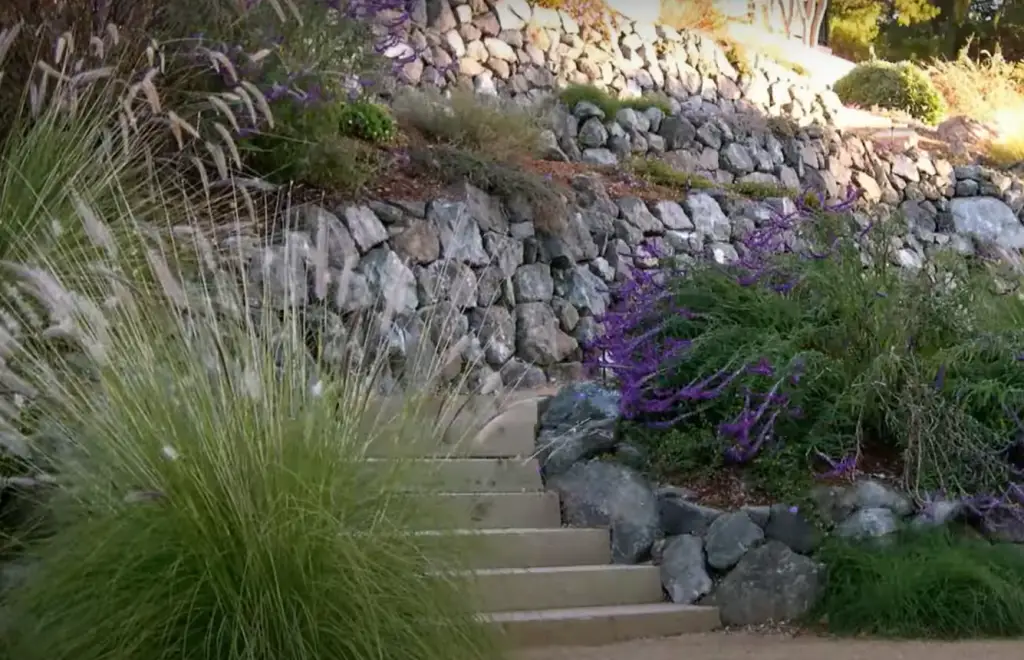
You can easily control the spread of creeping thyme by cutting back any branches or stems that become too long. And because it’s drought-tolerant, there’s no need for much maintenance during hot, dry periods. With its fragrant foliage and flowers, creeping thyme is an ideal way to enhance the look of a hillside stairway.
Serene Waterfall for Pool with Tiered Retaining Walls Accent
You can incorporate a natural-looking pool that is fed by a tiered, cascading waterfall with the help of retaining walls to create an even and level area. The extra height provided by these walls also adds depth and dimension to your yard, giving it an enhanced sense of definition. If you have access to the necessary machinery, you can easily build this feature without spending too much money. Just plan carefully and ensure all safety precautions are taken. Besides adding aesthetics, this type of feature also improves air circulation in the yard, making it more inviting for guests and family alike!
Add Seating and a Flood-Preventing Pond
Seating can be anything from benches to hammocks, or even terraces built into the hill. It’s an ideal way to add some visual interest while providing a nice spot to relax and take in the view. Additionally, adding a small pond at the base of the hill can help prevent flooding while also helping keep soil erosion in check. When installing these features, make sure they are securely anchored into the ground so they don’t move or float away when it rains. Also, opt for plants that can withstand heavy rain if possible. By planning ahead for wet weather, your landscaping will look better for longer!
Revamp the Hillside with Stone Walls Stairs, and Gazebo
Adding both beauty and functionality, this is an excellent way to maximize the outdoor space. A combination of all three can create an elegant yet practical look that will offer years of enjoyment for you and your family.
Stone walls are ideal for containing soil on steep hillsides without having to use large retaining walls. The stones should be chosen carefully as they need to fit together snugly and be strong enough to withstand the elements over time. Steps made from rocks or stones provide a decorative way to connect several areas of your yard while also providing safer passage up and down.
Gazebos are a great choice for providing a shady spot to relax and take in the view of your hillside landscape. A gazebo is a versatile structure that can be used as an outdoor living room, dining area, or even a gathering spot. You could also use it as an extension of your deck or patio. Make sure to choose materials that are durable yet lightweight so they don’t weigh too much on your hillside and also withstand any weather conditions.
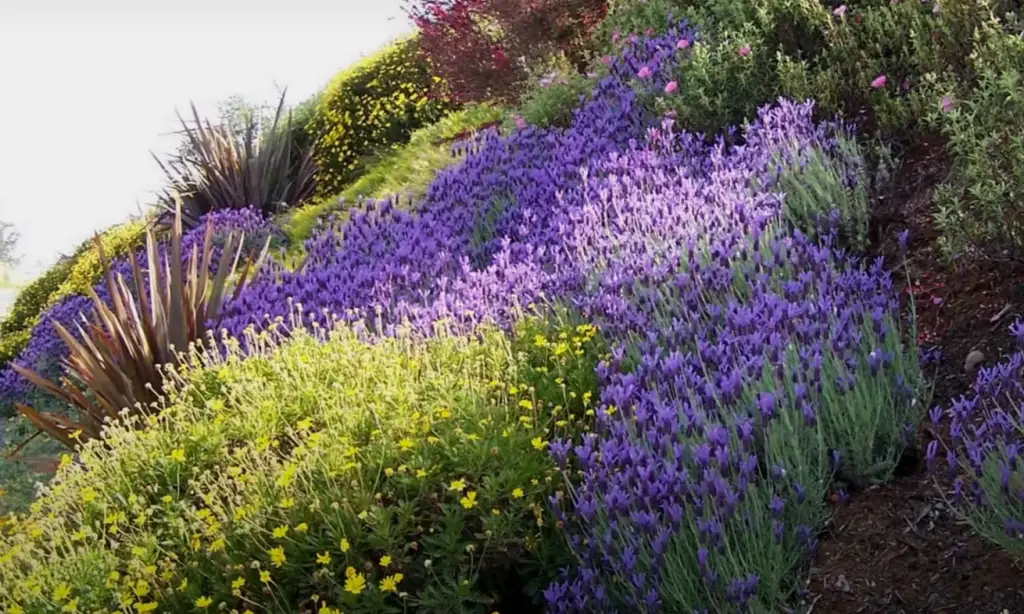
These three elements together will give your hillside landscape a polished look while still being budget friendly. Plus, you’ll get years of enjoyment out of these features with minimal maintenance required.
Embellish Stone Steps with Colorful Ground Cover
Stepping stones are a great way to create an attractive landscape on a hillside. They add visual interest and allow you to get around the slope easily. Adding colorful ground cover can further enhance the look of your steps while blending in with the natural environment. Consider planting creeping thyme, creeping phlox, or sweet woodruff for a low-cost option that will offer vibrant color all summer long. Be sure to select plants that will do well in your specific climate and soil conditions.
Once you’ve chosen the right plant, consider adding decorative elements like mosses, ferns and other foliage between each stone step for added texture and detail. You can also use light-colored gravel or mulch. Whatever option you choose, be sure to leave room for the plants to grow and spread out so they can cover any bare spots and give your hillside steps an even more attractive appearance.
Add Texture to the Retaining Wall with Climbing Ivy
While it’s not as easy to install as other materials, if you’re up for a little DIY project this is definitely something you should do! Plant climbing ivy at the base of the retaining wall in several spots and be sure to use a trellis or lattice work around the perimeter of your wall so that the ivy can grow up it. This will help keep your budget down by avoiding having to buy extra material for an artificial covering. The result is a beautiful and lush hillside with plenty of character!
Create Cohesive Retaining Walls
If your hillside is steep and needs to be held back, you’ll need to build retaining walls. This can get expensive, but there are ways for creating cohesive retaining walls on a budget. For instance, use stones of different sizes and materials such as cinder blocks or bricks in creative combinations that don’t break the bank. You can also incorporate plants and other natural elements into your design for an eco-friendly look that won’t cost too much. The key is to mix and match different materials so they complement each other while still providing the support needed for your slope.
Prevent Erosion with Creeping Phlox Ground Cover
It works great for sloping hillsides as it can fill in quickly, preventing soil erosion without needing much maintenance or care. The flowers range in color from pink to blue to white, adding a nice contrast against the lush green foliage. Creeping phlox does not require much watering and is an excellent choice for anyone looking to create a hillside landscape on a budget. Plus, its hardy nature means it will survive through many seasons with little effort on your part!
Incorporate Plants in Retaining Walls and Paving Stones
Retaining walls are a great way to create more usable space for your hillside landscape and also minimize erosion. Incorporating plants in the walls can brighten up the look and add living elements to the area. You can use different types of paving stones or bricks to form the wall and then fill it with soil and small shrubs or flowers. This is a beautiful and cost-effective way to spruce up the look of your landscape on a budget!

Another great idea is using decorative pavers as walkways and incorporating various flowering plants into them. This creates an inviting pathway that brings charm to your outdoor oasis while saving you some money.
Reclaimed Bricks Create Retaining Wall for Wildflower Beds
If you have an old brick wall around your house, why not use it to create a unique and attractive landscape feature? You can do this by building a retaining wall with the reclaimed bricks. This will give your garden some texture and color. To make things easier, you can purchase a kit or two of plastic interlocking blocks that fit together like a jigsaw puzzle. These are often used for hillside landscaping on a budget, and they’re easy to assemble without any tools. Once you’ve built the retaining wall from plastic blocks and bricks, fill it with high-quality topsoil, compost, and wildflower seeds for an inexpensive yet beautiful hillside garden. Be sure to water the area regularly to keep the flowers blooming. With this DIY project, you’ll have a beautiful and unique hillside landscape in no time! [1]
Raised Garden Beds
A raised garden bed is a great way to make the most of your hillside landscape. It will provide an area for plants to get plenty of sun, as well as provide protection against erosion and weed growth. Plus, it will instantly add a polished look to your slope!
You can easily create your own garden beds with some basic supplies like wood planks, screws, soil, and mulch. Make sure you properly measure the space you have available before buying any materials so that everything fits perfectly when you’re done.
Once the bed is built and filled with soil, then it’s time to start planting! Consider adding succulents or native flowering plants for color and texture.
Stone Steps and Uniform Brick Walls
Are you looking to give your hillside property a luxurious makeover?
Stone steps can be used to create an inviting staircase that will lead you up a lush hillside garden, while uniform brick walls will add privacy and security while providing a classic look. Installing stone steps is labor intensive and may require professional help, but with careful planning and budget management, you can find ways to make this project affordable.
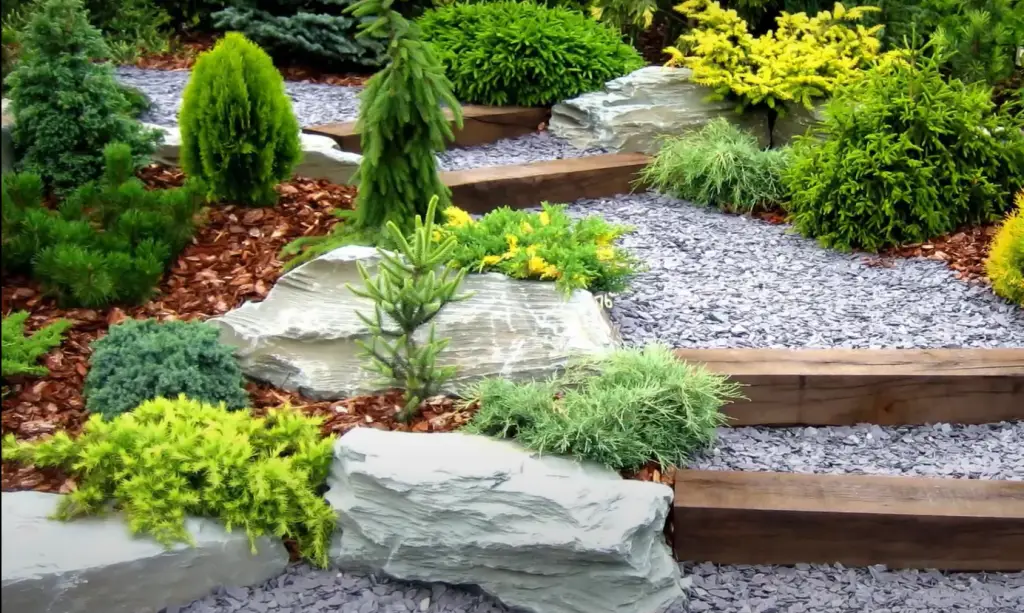
These structures provide an elegant addition to any outdoor space. You can easily personalize them with different colors of mortar or bricks for more eclectic style. Plus, there are lots of tutorials available online for creating the perfect wall for your hillside property.
Bring Rustic Elegance with Stone Slab Stairs
you have a hillside in your yard and want to add a touch of rustic elegance, then stone slab stairs are the way to go. They look great and can be installed on even the steepest slopes with relative ease. You can use natural slabs or purchase pre-cut stones from your local garden center or hardware store. To make sure that the steps are secure and level, it is essential to hire an experienced landscaper for proper installation. Once complete, stone slab stairs will provide a safe path up and down the hillside while adding charm and character to your landscape design.
Rock Wall Switchback Stairs
This can be achieved by using local rocks and stones, which are usually available at landscape supply stores. After you have collected the materials, you need to create the foundation for your steps that will support them. When done correctly, this project will give your yard a lavish look without breaking the bank!
Another benefit of this type of project is that it can help reduce soil erosion caused by water running down your slope. The walls will slow down the flow of water and help keep more soil in place. Additionally, switchback stairs make navigating up and down your hillside much easier than if there were no steps or pathways at all.
To get the most out of this project, make sure to install proper drainage behind each step. This will help ensure that any water that does run down your hillside is quickly diverted away from your home’s foundation and into a drainage system.
Get a Contemporary Vibe with Tiered Rock Garden
A tiered rock garden is perfect for creating this modern feel and requires minimal in terms of materials. Start by deciding on the type of rocks you would like, then build up the tiers that will create your hillside landscape look. Be sure to use rocks of different heights and sizes – not only does this make it look more interesting, but it also helps with drainage. Once you have your tiers in place, consider using ground cover plants or low-maintenance shrubs to fill out the space between them. With some careful planning, you can achieve an amazing contemporary vibe without much effort!
Spruce Up Mulch Beds with Plants
Mulch beds are an attractive way to break up the monotony of a plain hillside and create a splash of color. You can add life and vibrancy to your mulch bed by planting some shrubs, perennials, and other plants. When shopping for plants, consider their size and how they will look in the space. You should also think about what type of soil is needed for the plant’s growth and maintenance.
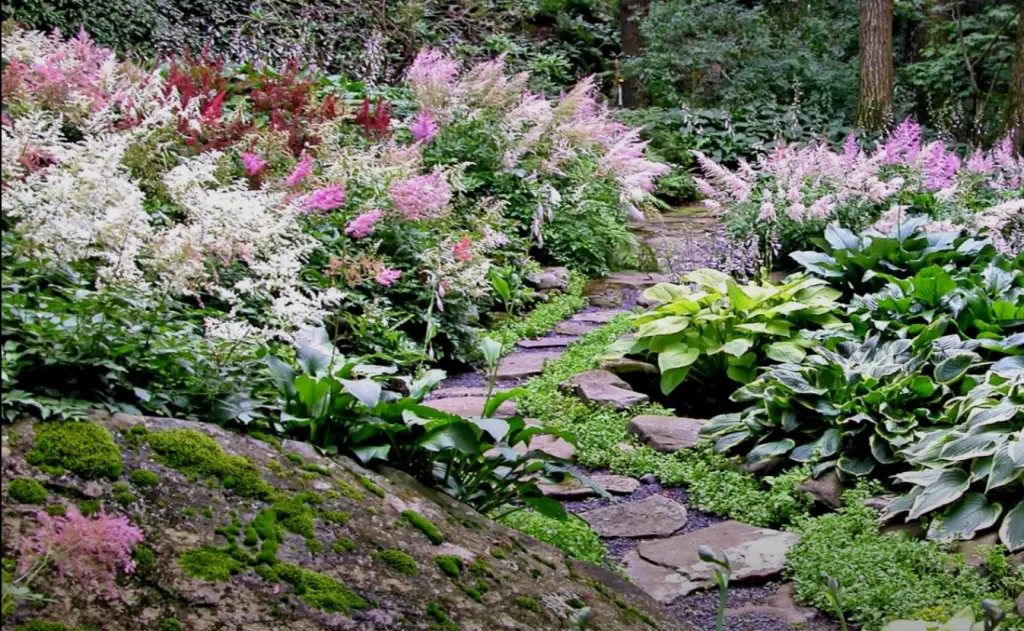
If you’re on a budget, try looking for smaller sizes or varieties that don’t require much care or attention after being planted. Whatever you choose, be sure to water the plants regularly so they stay healthy and vibrant! Additionally, consider adding elements like rocks or small pieces of wood to your mulch beds for an extra decorative touch. With a little creativity and careful planning, you can transform your hillside into a beautiful landscape that you’ll be proud of! [2]
FAQ
What is the best landscape material for a slope?
For a slope or hillside, you want to choose landscape materials that are strong and durable enough to withstand the elements. Gravel and mulch are great choices for landscaping on a budget. Both of these materials provide excellent drainage and help to reduce erosion from heavy rain or snowmelt. You can also use terracing, rock walls, boulders, or wood chips to keep soil in place and add visual interest to your landscape. Consider using plants with deep root systems to stabilize the soil further. [3]
What is the best landscaping for a steep hill?
The best landscaping for a steep hill will depend on both the environment and your personal preferences. If you’re looking to save money, then consider planting groundcovers or rock gardens on your hillside as an affordable alternative to grass. Using native plants is also a great way of creating a low-maintenance and budget-friendly landscape design. You can also add some color to your hillside by adding wildflowers or shrubs in pots, which don’t require much work but can still bring life to the area. If you have the budget, terracing and retaining walls are also great options for holding back soil erosion and preventing landslides! [4]
How do you deal with a sloped backyard?
Dealing with a sloped backyard can be challenging, but the right landscaping plan can help you make the best of your Hillside property. Here are some tips to get you started on transforming your sloped landscape into an enjoyable and functional outdoor space.
First things first, make sure you take into account all of the existing features of your hillside lot or slope before beginning any project. This includes understanding how much soil is present and what type it is – clay, sand or loam – as well as considering drainage issues. Depending on the slope and size of your hillside area, terracing may be necessary in order to create usable spaces for planting or other activities.
If possible, try to incorporate native plants into your Hillside landscaping design. Native plants are often hardier and require less maintenance than nonnative plants, making them ideal for slopes where water runoff can be an issue.
When planning out the layout of a sloped landscape, try to create natural levels with rock steps or retaining walls. These will help form terraces that can be used both functionally and aesthetically in order to make the most of your hillside space. Additionally, consider using vegetation to reduce erosion on your slope by planting shrubs or ground cover along its edges.
Finally, don’t forget about lighting when it comes to making the most of a hillside area. Low voltage lighting is great for highlighting specific features such as trees and pathways, and can really add a touch of magic to your Hillside landscaping design. [5]
How do you terrace a steep hillside?
Terracing a steep hillside is one of the most effective ways to landscape a sloped area. It can provide stability, prevent soil erosion, and even create usable space for gardens and other features. To terrace your hillside, you’ll need to start by planning out the design first. This includes marking off the areas where you want each step to be located as well as determining what materials will be used for building the terraces (such as rock or wood). Once that’s been established, it’s time to begin constructing your terraces using whichever method works best for you – either by hand or with tools like tractors and bulldozers. After the construction is complete, all that’s left to do is to choose the plants and other features that will be included in your terrace design. With a little bit of creativity, you can create an attractive and functional hillside landscape on a budget!
Useful Video: 27 Best Hillside Landscaping Ideas on a Budget
Conclusion
Hillside landscaping projects may seem intimidating, but with a few smart and affordable ideas from this guide, you can create a stunning outdoor space without breaking the bank. When planning your project, make sure to take into account important factors like soil type, slope grade and water drainage to ensure that everything will work the way you want it to. With a bit of effort and creativity, you can transform your hillside into an attractive and functional outdoor area. Good luck!
References:
- https://www.decorhomeideas.com/hillside-landscaping-ideas-on-a-budget/
- https://www.outdoorhappens.com/sloped-backyard-ideas-on-a-budget/
- https://lawnlove.com/blog/creative-ways-to-landscape-on-a-slope/
- https://www.thespruce.com/hillside-landscaping-ideas-4163358
- https://www.westlakedevelopmentllc.com/2021/03/04/what-to-do-with-sloping-backyard/





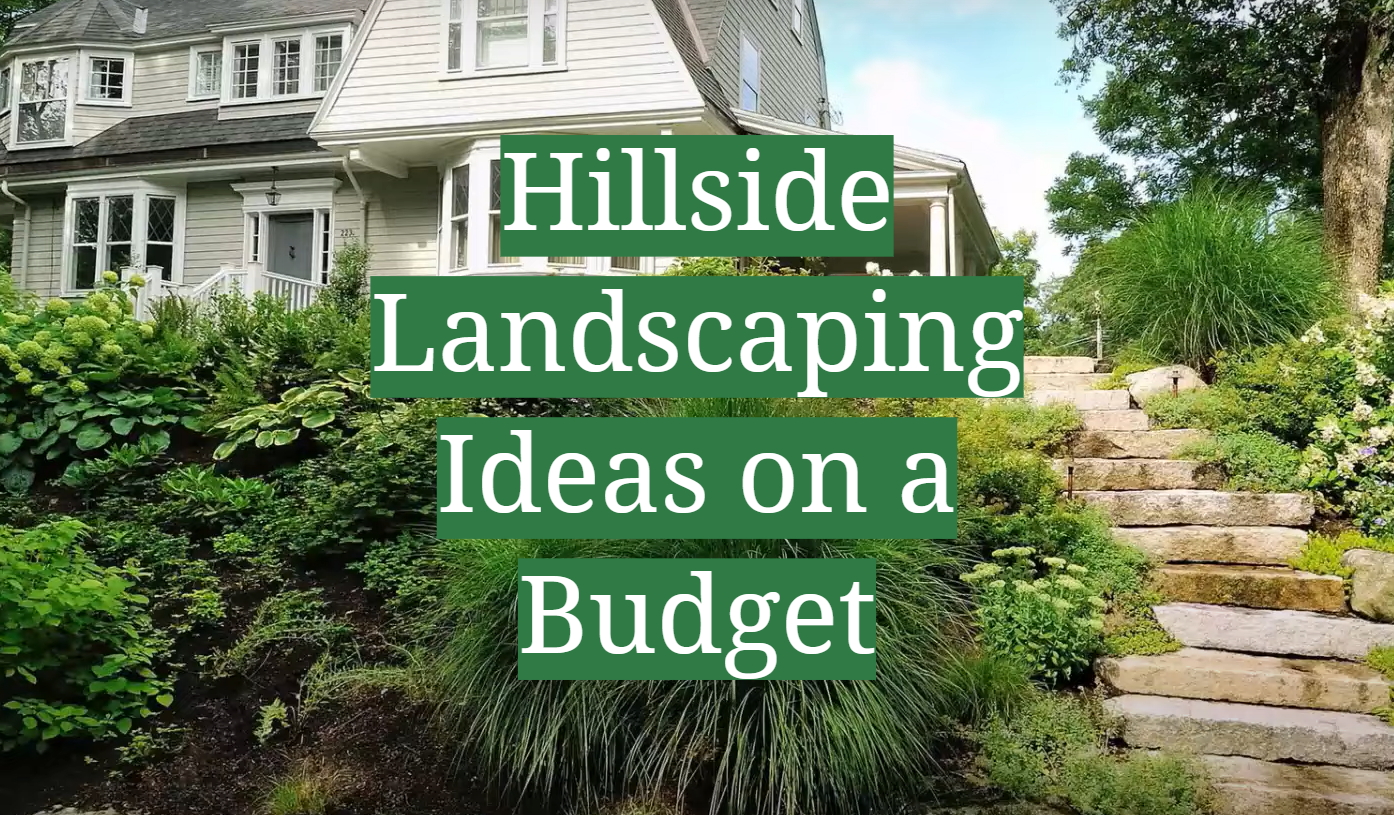




Leave a Reply
View Comments